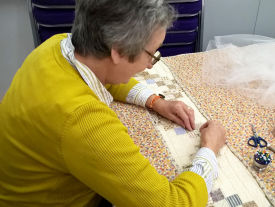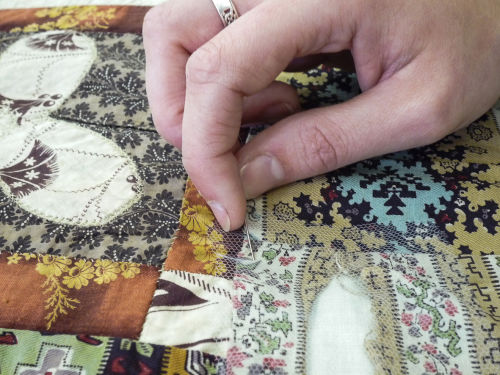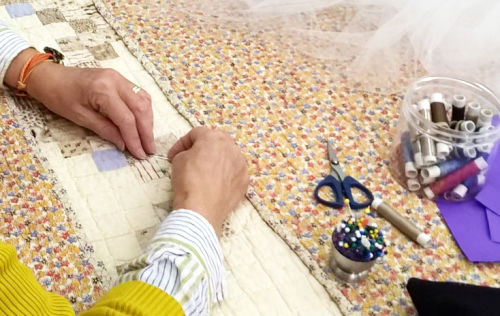Conservation Volunteers at The Quilters' Guild
Published: Monday, 11th December 2017 13:11 PM

The Quilters’ Guild is dedicated to preserving patchwork and quilting heritage, and the objects within The Quilters’ Guild Collection require dedicated care and handling to ensure they are preserved for as long as possible. Textiles, like all other materials, are subject to deterioration and can be very fragile items. Whilst we do not have our own dedicated conservation studio or conservation professional, we are very fortunate to benefit from a team of highly skilled volunteers who can apply textile conservation techniques to some of our fragile pieces, ensuring their longevity and providing the potential to display these pieces in future exhibitions.
There are several factors that cause damage to textiles. As everyday objects with a practical function, normal wear and tear is a common factor, leading fabrics to become threadbare and worn. Pest activity could also have played its part, with the larvae of the carpet beetle or clothes moth having a lot to answer for in fabrics such as silk and wool. In some cases the problem is inherent in the manufacturing process of the fabric itself. Unstable chemical dyes and metal based mordants, required to fix the dye to the fabric deteriorate the fibres over time, eating away at their structure and causing them to weaken and become brittle, leading shattering or holes as time progresses.
There is nothing we can do once this irreversible deterioration has taken place. However, what we can do is provide support and stability to the sections that remain intact and the piece as a whole. The main type of conservation undertaken by our volunteers is netting. This involves carefully sewing monofilament netting over the surface of a damaged patch or area using ultrafine, colour coordinated thread. The net is so fine and delicate that it appears transparent when placed over the patchwork. This process helps to provide strength to the piece and protect the damaged area from further decay.
Meet Meg, Conservation Volunteer.
Meg is one of our conservation volunteers at The Quilters’ Guild. Originally Meg joined us as a Gallery Steward, which she reliably continued from the Quilt Museum opening until its closure in 2015. Meg’s sewing skills and passion for historic textiles soon became apparent when she assisted in preparing several quilts for exhibition that needed a small amount of netting to make them more stable for display.
When asked why she was drawn to volunteering as a Collection Conservation Volunteer, she said she felt it had a great sense of importance, both in terms of looking after the past and looking towards the future - in her words ‘Keeping our heritage of these wonderful pieces of history alive for future generations’. Her greatest enjoyment is knowing that, ‘once completed, the quilt or coverlet can be seen by the public. It may not have been seen by anyone for many years, perhaps since it was donated’ and ultimately that provides ‘satisfaction of a job well done!’
This is definitely a time consuming role which requires a lot of patience. How long does it take? “It depends on the size of the damaged area†says Meg. “I can cover say an inch square piece in about fifteen minutes. That’s why a quilt or coverlet that has a lot of deterioration can take several weeks to completeâ€.
When asked what one quality is need to be a good conservation volunteer she replied ‘Concentration! Once I get started I’m in a world of my own concentrating on the work. I may be heard to mutter the odd mild expletive as thefine netting and ultrafine thread I use can sometimes be difficult to see, say against a light fabric.But it is worth all the hard work. The pieces I get to work on are really beautiful’.
 A fine monofilament netting is applied to stabilise the damage on a coverlet
A fine monofilament netting is applied to stabilise the damage on a coverlet
 Meg sews netting to one of our new acquisitions to the Collection
Meg sews netting to one of our new acquisitions to the Collection